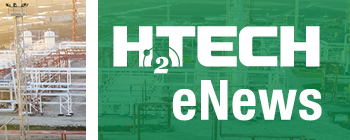News
ÖBB and voestalpine lay the world's first H2-based rail in Linz
ÖBB CEO Andreas Matthä and voestalpine CEO Herbert Eibensteiner laid a globally unique rail at Linz Central Station: the H2-based material used was produced with net-zero CO₂ emissions. With this innovation, the two leading Austrian companies aim to significantly reduce railway-related CO₂ emissions in the long term – marking another milestone on the path to climate-neutral mobility.
"Innovations ‘Made in Austria’ like this are a key reason why the Austrian railway industry ranks among the best in the world. In Europe, we are even the undisputed leader in per capita exports. Our clear mission is to further expand this international pioneering role and actively shape the mobility transition," emphasized Federal Minister Peter Hanke.
"Every train journey starts with the first meter of rail. Today, this journey into a sustainable mobility future has gained even more momentum. One future meets another here: the H2-based rail meets the critical four-track expansion," said ÖBB CEO Andreas Matthä.
H2 instead of coal – green technology makes it possible. For the first time worldwide, a rail has been manufactured using H2-based technology. Green H2 replaces fossil fuels in the production process. voestalpine CEO Herbert Eibensteiner stated, “At voestalpine, we have already successfully launched our transition to green steel production and are progressing rapidly with the construction of two electric arc furnaces powered by green energy in Linz and Donawitz. At the same time, we are conducting research on various breakthrough technologies in collaboration with industry and science partners . Producing the world’s first H2-based rail at our Donawitz site is a historic milestone.”
The climate-neutral rail also makes a key contribution to the circular economy – as it is made entirely from recycled materials.
High-tech from Donawitz – Quality and Sustainability ‘Made in Austria’. The innovative rail was produced in Donawitz, Styria, home to one of the most modern rail rolling mills in the world. It was delivered just-in-time to Linz Central Station within a few hours – supporting regional value creation and efficient logistics. This innovation once again highlights Austria’s international leadership in rail technology.
A strong signal from Upper Austria for Europe’s railway future. With today’s achievement, ÖBB and voestalpine are sending a powerful message – not just for innovation and climate protection, but also for the capabilities of Austria’s industrial sector. “With the world’s first H2-based rail, we are proving that Upper Austria’s industry doesn’t just have a proud history – it is actively shaping the future. Climate-neutral steel, modern railway infrastructure, and sustainable mobility – made in Upper Austria. This symbolizes what makes our region strong: smart minds, skilled hands, and innovative companies. These are the foundations of the competitive edge and locational advantages we need to stay ahead tomorrow,” emphasized Governor Thomas Stelzer.
The rail was laid as part of construction work at the west exit of Linz Central Station – a key section of the continuous four-track expansion of the Western Line between Vienna and Wels. The “Linz Central Station West Side” project is creating essential capacity for the rail traffic of the future.
"Four tracks will eliminate the bottleneck between Linz and Wels. This will enable better train services in the central Upper Austria region," said Regional Minister for Infrastructure Günther Steinkellner. Both passenger and freight train capacity will increase. The four-track expansion from Linz toward Wels is key to achieving this. Passengers will benefit greatly: a denser S-Bahn system in the Linz-Wels area, an integrated timetable, and an overall improved offering in regional and express train services. In addition, new, modern, and barrier-free stops with park-and-ride facilities will enhance the travel experience.

